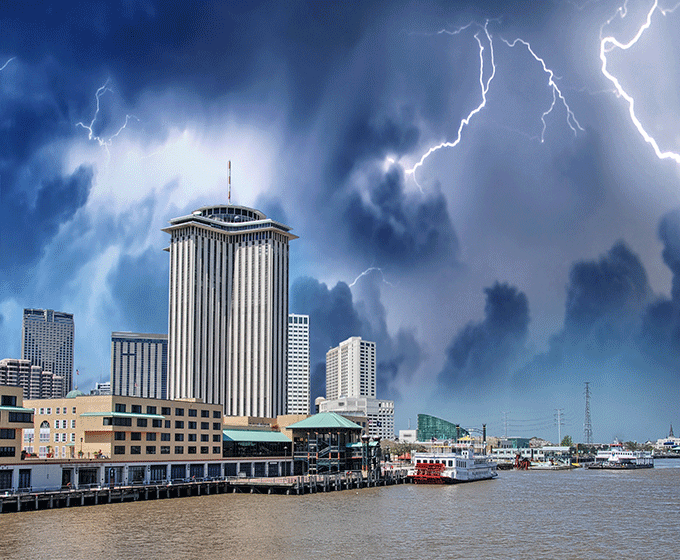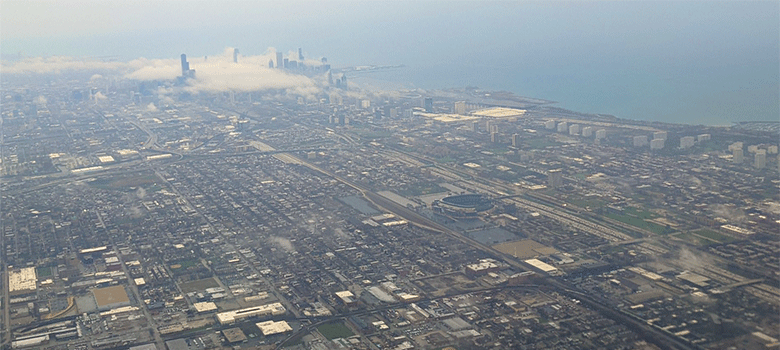
Of the 32 cities studied by researchers at UTSA and LSU, New Orleans had the largest Urban Convection Ratio, suggesting its urban environment greatly enhances thunderstorm activity.
JUNE 7, 2022 — To better understand the impact that urban environments have on storms and rainfall, two researchers from The University of Texas at San Antonio (UTSA) collaborated with colleagues at Louisiana State University (LSU) to observe how metro areas throughout the Southeastern United States enhance thunderstorm frequency.
Neil Debbage, an assistant professor of geography and environmental sustainability in the UTSA College of Liberal and Fine Arts, and graduate geography student Jewel Uzquiano worked with doctoral student Robert Forney and geography professor Paul Miller of LSU. The collaboration resulted in a NASA-supported research paper that was published in the May 2022 issue of Urban Climate.
Debbage has studied the effects of large cities on climatology for some time. Urban cores have long been constructed with heat-absorbing materials like concrete, steel and asphalt. Cities also have a higher concentration of machines that pump heat into the atmosphere and generally have a lower concentration of cooling vegetation. This increased temperature in large metro areas provides a source of unstable air, which has the capability of producing clouds leading to more frequent rainfall and thunderstorms. This is commonly known as the urban rainfall effect.
Although the understanding of the urban rainfall effect has grown more robust over the decades, studies have generally focused on a limited number of large cities. Aiming for more accurate comparisons, the UTSA-LSU collaborative examined weakly-forced thunderstorms from 2001 to 2015 in 32 urban environments across the Southeastern U.S. The team’s focus included large metro areas such as Atlanta, Miami and New Orleans as well as smaller ones such as Hickory, N.C., Jackson, Miss., and Huntsville, Ala.

In this photo, air flowing over the downtown area of Chicago is forced upward forming clouds. This is one factor that contributes to the phenomenon more commonly known as the urban rainfall effect. Photo courtesy of Kyle S. Mattingly
To accomplish this feat, the team developed a methodology to create an Urban Convection Ratio (UCR) for each city. The UCR compared the frequency of weakly-forced thunderstorms—which are storms driven largely by instability and moisture rather than the synoptic-scale lifting of air and wind shear—to the frequency of storms anticipated as a result of geophysical factors alone, allowing the researchers to isolate urban influences on thunderstorm activity.
Of the 32 cities in the study, these 10 had the largest UCRs:
Although coastal metros such as New Orleans have historically made it more challenging to precisely identify urban effects on rainfall—due to their increased interaction with sea breezes and tropical disturbances—Debbage said the cities at the top of the list absolutely warrant additional investigation.
“I think this study sets the stage for future modeling work to more fully understand the specific physical mechanisms that explain the large UCRs in New Orleans, Memphis and Tampa,” he explained.
While New Orleans, Memphis and Tampa could prove to be informative study sites for the urban rainfall effect, two other top 10 entrants offered even more striking insights.
“One of the more notable findings was that several relatively smaller cities like Knoxville and Norfolk exhibited significant thunderstorm enhancements,” Debbage said. “This suggests that the urban rainfall effect is potentially widespread throughout the Southeast.”
The researchers were also surprised to find that two urban areas they examined actually suppressed thunderstorm activity: Winston-Salem, N.C., and Hickory, N.C., which ranked third-to-last and last, respectively, in UCR size among the cities studied. In Hickory’s case, the group surmises that the city’s interactions with the mountainous topography of the Appalachians to the west could reduce thunderstorms. In addition to cities with large UCRs, these two areas certainly merit further analysis.
Moving forward, Debbage hopes to apply the UCR approach to additional urban environments beyond the Southeast. One of the driving forces behind his research is urban flood resiliency. A better understanding of the urban rainfall effect will inform city leaders and first responders on how to prepare for potentially hazardous weather events.
“To fully prepare for flooding, urban planners and emergency managers likely need to account for urban amplification of precipitation,” Debbage explained. “It is, in many respects, a double whammy, where urban environments can increase the initial rainfall and increase runoff once the precipitation reaches the ground.”
In addition to research on urban climatology, natural hazards, weather modeling and sustainability, Debbage regularly teaches courses in weather, climate, physical geography and GIS mapping.
In fact, his graduate student, Uzquiano, was responsible for the GIS visualizations and cartography for this research project.
UTSA is a Tier One research university that is committed to tackling society’s grand challenges through world-class education and research programs. With an emphasis on transdisciplinary collaboration, innovation and entrepreneurship, it is leveraging its research and development capabilities to benefit the San Antonio community and the world beyond.
UTSA Today is produced by University Communications and Marketing, the official news source of The University of Texas at San Antonio. Send your feedback to news@utsa.edu. Keep up-to-date on UTSA news by visiting UTSA Today. Connect with UTSA online at Facebook, Twitter, Youtube and Instagram.
After getting your student settled in their room, connect with other UTSA families at our Family Get Together. Attendees need to RSVP for the event.
Rock & Brews Restaurant - 5702 Landmark Pkwy, San Antonio, TX 78249Late Night at the Rec is an awesome UTSA tradition that turns a typical information session into an exciting night of fun. It's a unique opportunity to meet new people and reconnect with old friends.
Campus RecreationCheer on the UTSA Soccer team as they take on Lamar in the first home game of the season.
Park West FieldShow your UTSA pride with our spirited crew—Rowdy, Cheer, the Spirits of the Roadrunner, and the incredible Spirit of San Antonio Marching Band (SOSA)—as we light up the night in true Roadrunner style.
Main Campus East Lawn, Main CampusAnnual Giving will host a First Day of School celebration to welcome students back to campus. We will have giveaways and photo opportunities.
Sombrilla Plaza, Main CampusEnjoy snacks while connecting with Adobe reps and student ambassadors. Download or log into the Adobe Express app to snag swag and unlock exclusive back-to-school templates. It’s a fun, fast way to get creative and start the school year with bold moves.
Central Plaza, Main CampusCelebrate the merger of UTSA and UT Health San Antonio with a pop-up featuring free t-shirts, exclusive swag, and interactive photo opportunities. Open to all students, faculty and staff. Supplies are limited!
Sombrilla Plaza, Main CampusThe University of Texas at San Antonio is dedicated to the advancement of knowledge through research and discovery, teaching and learning, community engagement and public service. As an institution of access and excellence, UTSA embraces multicultural traditions and serves as a center for intellectual and creative resources as well as a catalyst for socioeconomic development and the commercialization of intellectual property - for Texas, the nation and the world.
To be a premier public research university, providing access to educational excellence and preparing citizen leaders for the global environment.
We encourage an environment of dialogue and discovery, where integrity, excellence, respect, collaboration and innovation are fostered.